AMD FX-8320E CPU Review: The Other 95W Vishera
by Ian Cutress on January 13, 2015 10:00 AM ESTProfessional Performance: Windows
Agisoft Photoscan – 2D to 3D Image Manipulation: link
Agisoft Photoscan creates 3D models from 2D images, a process which is very computationally expensive. The algorithm is split into four distinct phases, and different phases of the model reconstruction require either fast memory, fast IPC, more cores, or even OpenCL compute devices to hand. Agisoft supplied us with a special version of the software to script the process, where we take 50 images of a stately home and convert it into a medium quality model. This benchmark typically takes around 15-20 minutes on a high end PC on the CPU alone, with GPUs reducing the time.
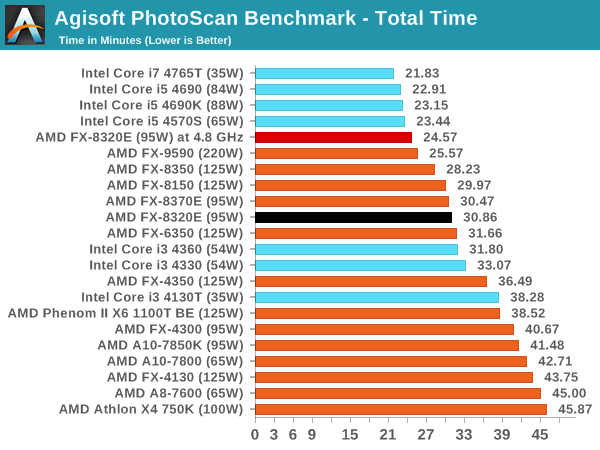
A highly parallel benchmark like Photoscan puts the FX CPUs ahead of our i3 results. When overclocked, it plays just behind the i5 results.
Cinebench R15
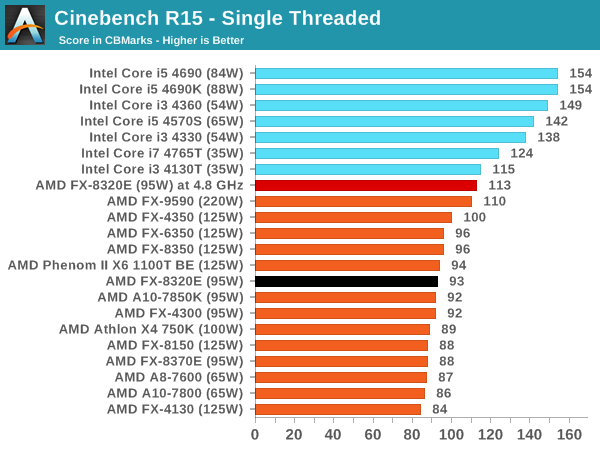
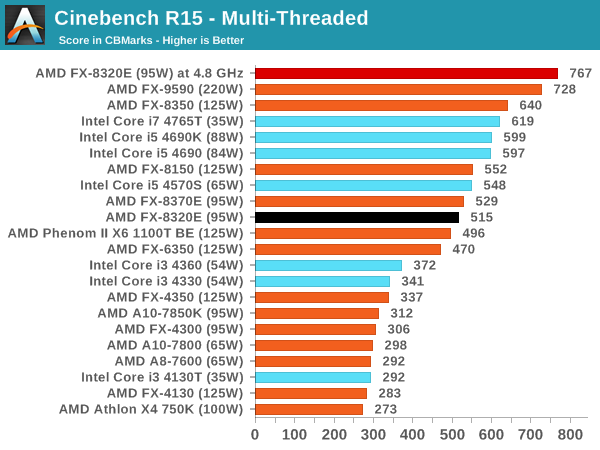
Professional Performance: Linux
Built around several freely available benchmarks for Linux, Linux-Bench is a project spearheaded by Patrick at ServeTheHome to streamline about a dozen of these tests in a single neat package run via a set of three commands using an Ubuntu 14.04 LiveCD. These tests include fluid dynamics used by NASA, ray-tracing, molecular modeling, and a scalable data structure server for web deployments. We run Linux-Bench and have chosen to report a select few of the tests that rely on CPU and DRAM speed.
C-Ray: link
C-Ray is a simple ray-tracing program that focuses almost exclusively on processor performance rather than DRAM access. The test in Linux-Bench renders a heavy complex scene offering a large scalable scenario.
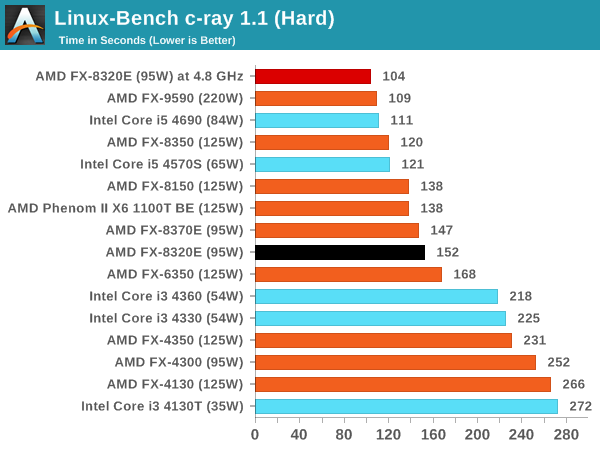
Ahead of the i3, behind the i5 until overclocked seems to be a good motto for this CPU.
NAMD, Scalable Molecular Dynamics: link
Developed by the Theoretical and Computational Biophysics Group at the University of Illinois at Urbana-Champaign, NAMD is a set of parallel molecular dynamics codes for extreme parallelization up to and beyond 200,000 cores. The reference paper detailing NAMD has over 4000 citations, and our testing runs a small simulation where the calculation steps per unit time is the output vector.
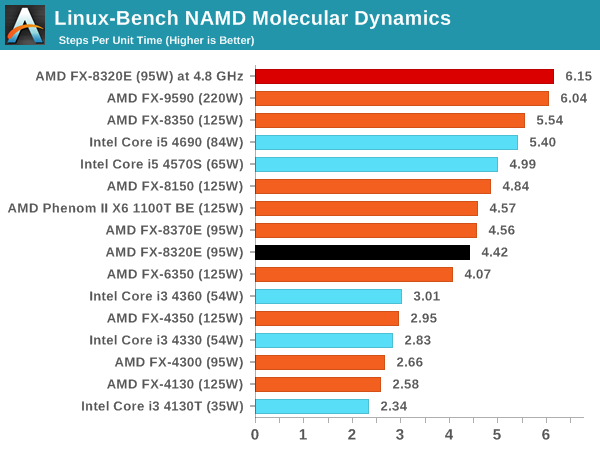
NPB, Fluid Dynamics: link
Aside from LINPACK, there are many other ways to benchmark supercomputers in terms of how effective they are for various types of mathematical processes. The NAS Parallel Benchmarks (NPB) are a set of small programs originally designed for NASA to test their supercomputers in terms of fluid dynamics simulations, useful for airflow reactions and design.
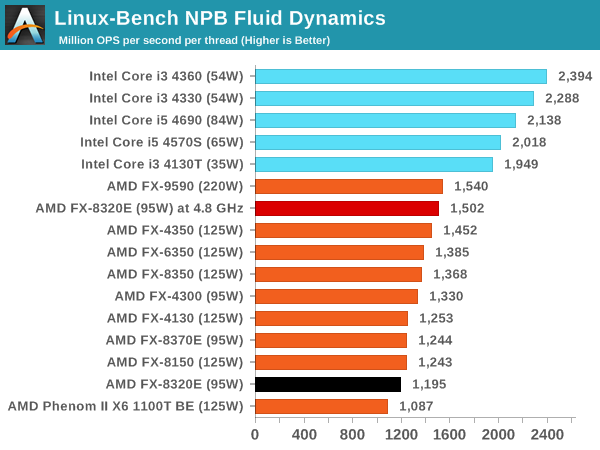
Redis: link
Many of the online applications rely on key-value caches and data structure servers to operate. Redis is an open-source, scalable web technology with a b developer base, but also relies heavily on memory bandwidth as well as CPU performance.
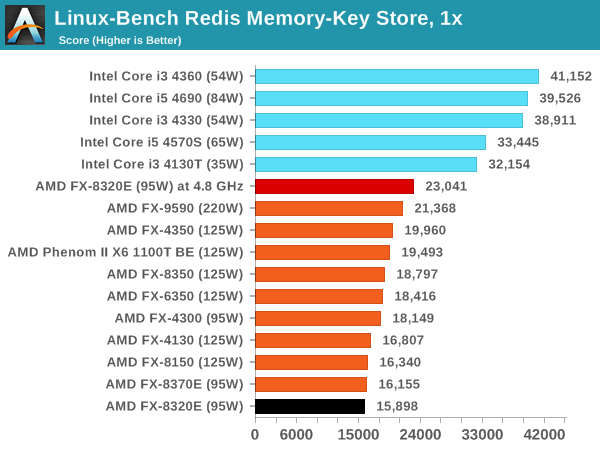
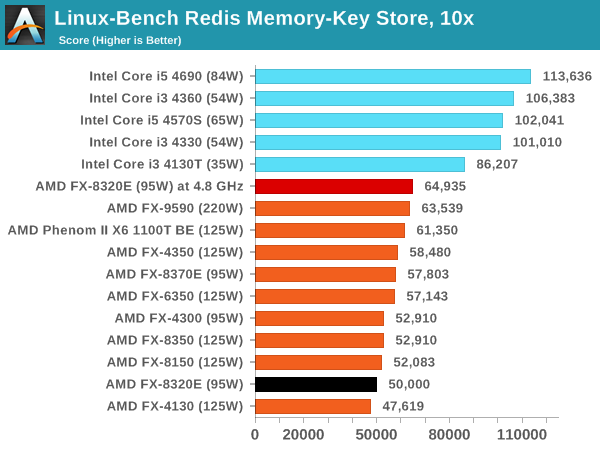
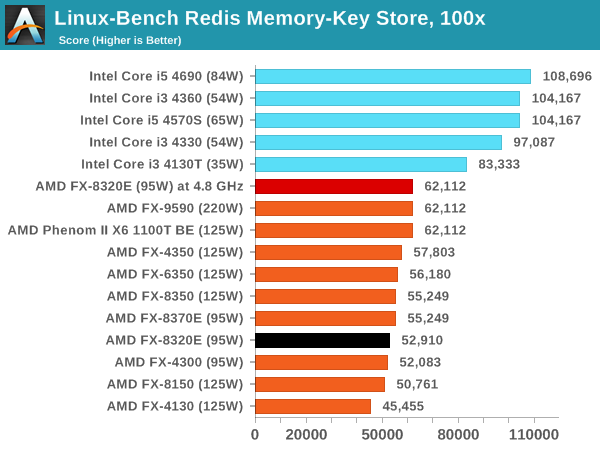
It would seem that one downside to the AMD FX line is the memory access limited scenarios, unless more cores can come into the equation. For redis, that is unfortunately not the case.










92 Comments
View All Comments
happycamperjack - Wednesday, January 14, 2015 - link
That's why I put "maybe". It's definitely not an ideal game to use for benchmark that's for sure.Zap - Wednesday, January 14, 2015 - link
Games that people are playing? You mean those super demanding ones like League of Legends and World of Warcraft, right? Because those two games have the lion's share of active gamers and actual game time right now. Since WoW's latest expansion came out, the two combined (using Raptr numbers) are 35% of the actual time spent in game for all PC gamers combined, trailed distantly by DotA2 at around 5% in 3rd place. "Demanding" games like BF4 can't even break the top 10, and barely exceed 1%.jabber - Thursday, January 15, 2015 - link
I would add the Sims to that very small list. The games I see installed on customers machines are actually pretty rare. In fact if you want to cover 90% of PC users then just include a Solitaire benchmark.dr_psy - Tuesday, January 13, 2015 - link
When are you people to stop that crappy "Power Consuption Delta" and come back to the raw values?This alone is reason enought to think in another webs to find reviews. Much more thes days when the power consuption values are so important. :(
hojnikb - Tuesday, January 13, 2015 - link
c'mon amd, update your damn chipsets. Having almost 6 year old chipsets (900 series is really nothing more than just a rebadge of 800 series) with no entery level option (like h81 with intel) is just sad for a platform that is suposibly aim at budget segment.Acreo Aeneas - Tuesday, January 13, 2015 - link
You do realize this is a article about a AMD CPU right? AMD CPUs are not compatible with Intel chipsets. Wish people would read the article before coming up with random commentry.hojnikb - Tuesday, January 13, 2015 - link
who was talking about compatability with intel chipsets ?I'm just pointing out, that amd has no budget chipset option (yeah, i'm not gonna cout 760G, since that stuff is literally ancient).
hojnikb - Tuesday, January 13, 2015 - link
>Wish people would read the article before coming up with random commentry.Same could be said for you.
silverblue - Tuesday, January 13, 2015 - link
That's not what (s)he said. The 970 isn't as budget as we'd like - it can be about twice the price of an H81 board - and they're still on 65nm fabrication which means slightly higher system power consumption. A refreshed chipset for FX may not make sense, but if they were to offer more USB 3.0 ports, PCIe 3.0 and - heaven forbid - a 32nm southbridge, and cutting the price down a little, an FX system would make a little more sense.hojnikb - Tuesday, January 13, 2015 - link
Exactly my point. You can grab a cheap h81 mobo and the cheapest i5 for around the same money as 8320 and 970 mobo. And with intel you get superior platform (even the cheapest chipset offers native usb3 and pcie3), power consumption and better single thread performance.These amds make little sense outside of very specific workload, where many bulldozer cores come in handy.